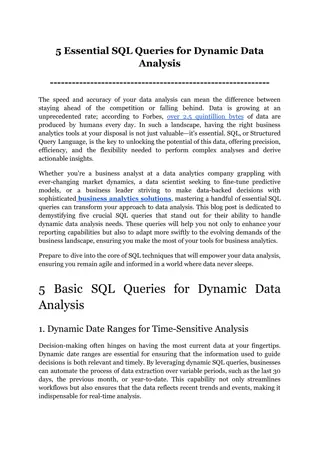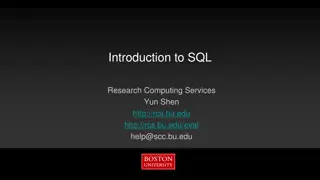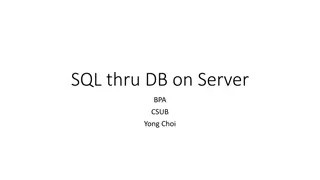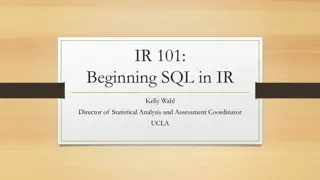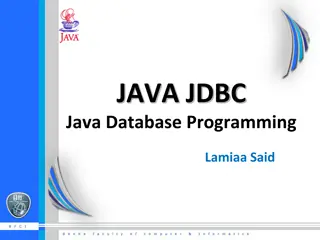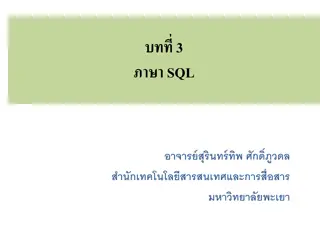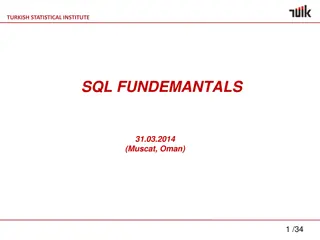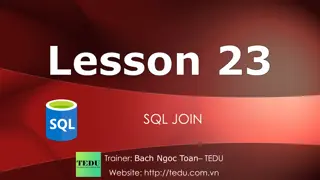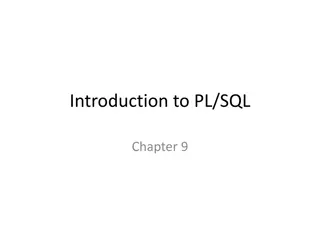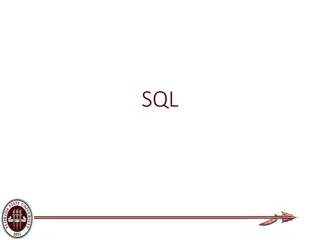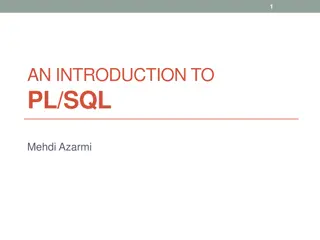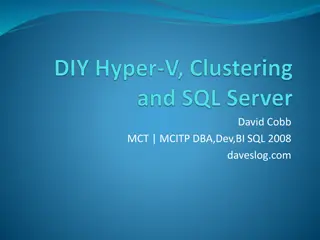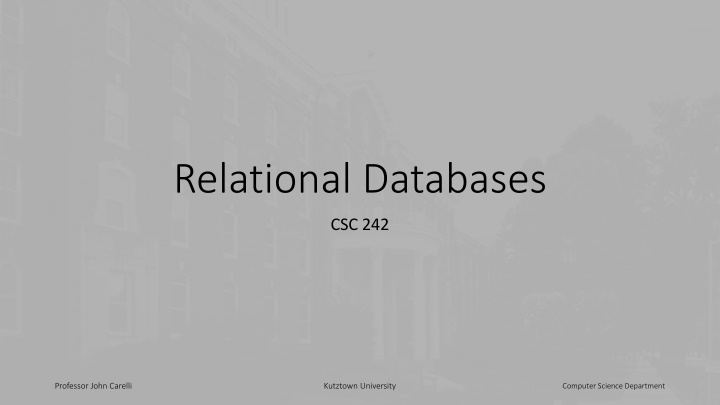
Understanding Relational Databases and Database Management Systems
Explore the fundamentals of relational databases, DBMS, table relationships, database languages, normalization, and SQL. Learn about primary and foreign keys, data manipulation, and the importance of database normalization in organizing data effectively.
Download Presentation

Please find below an Image/Link to download the presentation.
The content on the website is provided AS IS for your information and personal use only. It may not be sold, licensed, or shared on other websites without obtaining consent from the author. If you encounter any issues during the download, it is possible that the publisher has removed the file from their server.
You are allowed to download the files provided on this website for personal or commercial use, subject to the condition that they are used lawfully. All files are the property of their respective owners.
The content on the website is provided AS IS for your information and personal use only. It may not be sold, licensed, or shared on other websites without obtaining consent from the author.
E N D
Presentation Transcript
Relational Databases CSC 242 Professor John Carelli Kutztown University Computer Science Department
Databases A database is an organized collection of data. A database management system (DBMS) provides mechanisms for storing, organizing, retrieving and modifying data for many users. Examples of DBMS s: Microsoft SQL Server, MySql, PostgreSQL, MongiDB, SQLite Today s most popular database management systems are relational databases. A relational database organizes data in tables Tables refer to each other Professor John Carelli Kutztown University Computer Science Department
Relational Databases A relational database stores data in tables with rows and columns. Each row contains information for a unique item in the table Rows are also referred to as records Each row contains a unique key that identifies that row Each column of a table contains information about the item referenced in a given row. Columns are also referred to as attributes Professor John Carelli Kutztown University Computer Science Department
Relationships Between Tables Primary key Attribute (or attributes) that uniquely identify a given row in a table Used for record retrieval and to facilitate relationships between tables Foreign key Creates a table relationship by referring to the primary key in another table Primary key is often an integer that auto-increments when a new row is added to the table. Professor John Carelli Kutztown University Computer Science Department
Database Languages Three Primary Tasks Data Definition Defines/creates the type(s) of data and relationships Query Retrieve/Read information from DB Data Manipulation Data insertion, deletion, and updating Professor John Carelli Kutztown University Computer Science Department
Relational Database Normalization Normalization is a systematic approach to organizing relational database tables to eliminate data redundancy and data manipulation anomalies Types of anomalies: Update Anomaly Insertion Anomaly Deletions Anomaly Database Normalization Source: Dylan Schwesinger Kutztown University Computer Science Department
SQL Structured Query Language CRUD Create Read Update Delete Features Can perform all primary tasks (CRUD) Provides command-based access to information in tables commands are case-insensitive(case doesn t matter) Declarative Language Describes what tasks to perform not how to perform them left up to the Database Management System Professor John Carelli Kutztown University Computer Science Department
SQL Table Creation/Deletion Create a new table CREATE TABLE Name (Column1 Type1, Column2, Type2, ) (Type# indicates the type of data, i.e. integer, string, real, etc ) Specify a Primary Key CREATE TABLE Name (Column1 Type1 PRIMARY KEY, Column2, Type2, ) Column data restrictions CREATE TABLE Name (Col1 Type1 NOT NULL, Col2 Type2 DEFAULT NULL ) NOT NULL - data cannot be NULL or empty DEFAULT NULL - data defaults to NULL or empty Delete an existing table DROP TABLE Name Professor John Carelli Kutztown University Computer Science Department
Basic SQL Query Commands Selecting column information from a table SELECT column1, column2....columnN FROM table_name Selecting column information that meets a condition SELECT column1, column2....columnN FROM table_name WHERE Item1 = Value1 Selecting column information that meets multiple conditions SELECT column1, column2....columnN FROM table_name WHERE Item1 = Value1 {AND|OR} Item2 = Value2 Professor John Carelli Kutztown University Computer Science Department
More SQL Queries Select everything matching a condition SELECT * FROM table_name WHERE Item1 = Value1 Select items using a wildcard SELECT * FROM table_name WHERE Title LIKE %match% Will match anything containing the string match Professor John Carelli Kutztown University Computer Science Department
Modifying the Database Remove (delete) information from a table DELETE FROM table_name WHERE Item1 = Value1 Insert new items (a row) INSERT INTO table_name (Item1, Item2, ) VALUES (Value1, Value2, ) Modify stored data UPDATE table_name SET Item1=Value1, Item2=Value2 WHERE Item3=Value3 Professor John Carelli Kutztown University Computer Science Department


